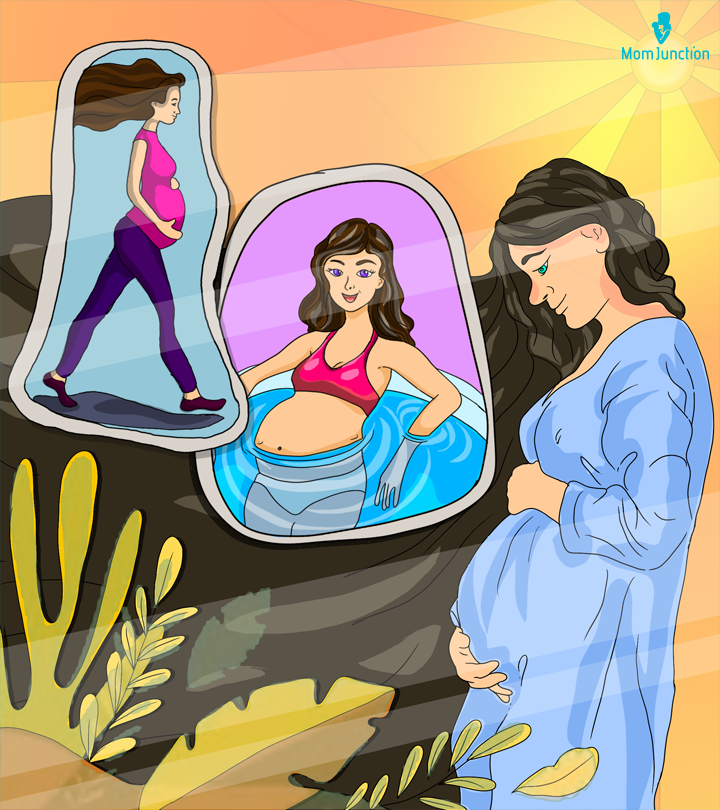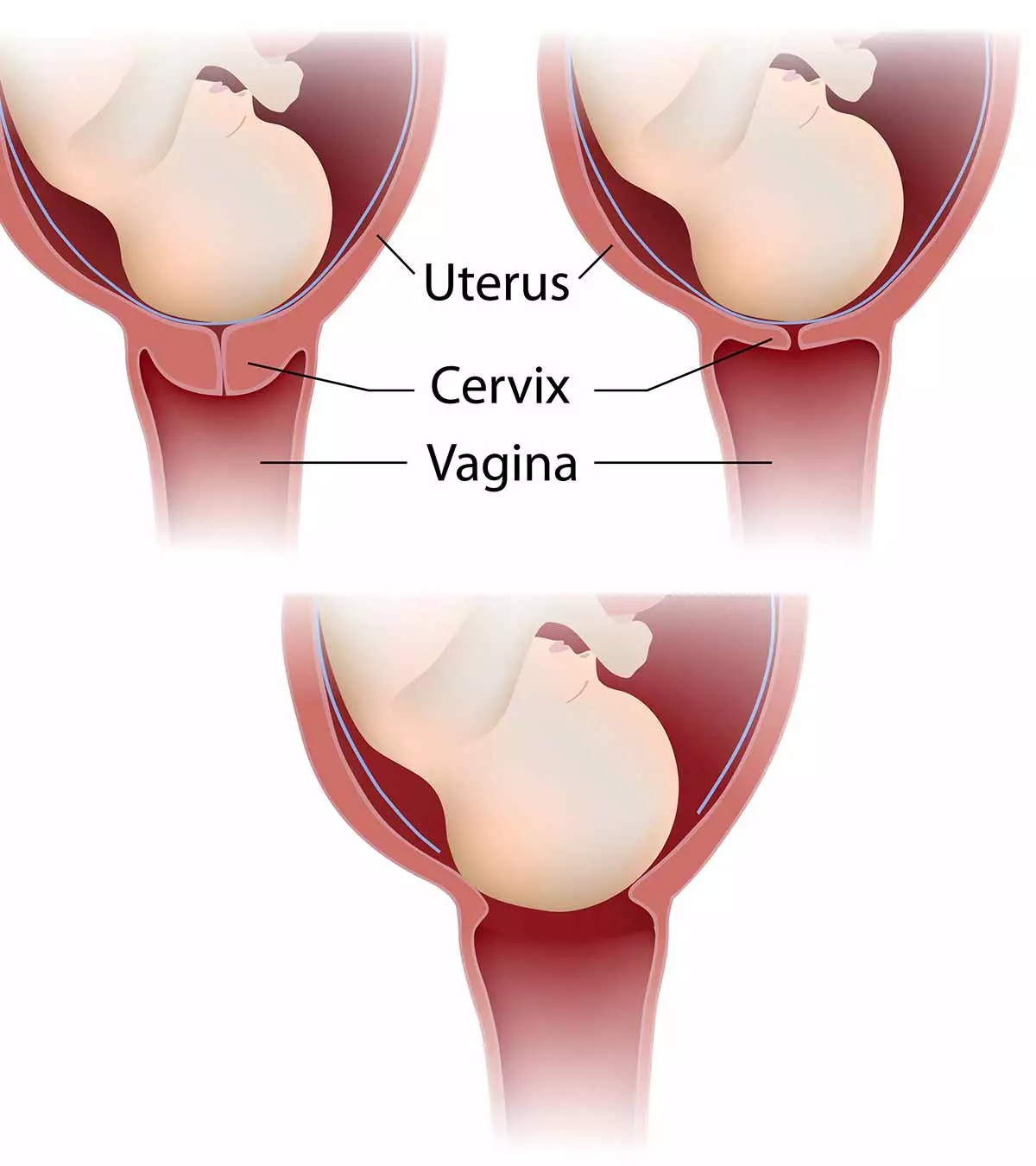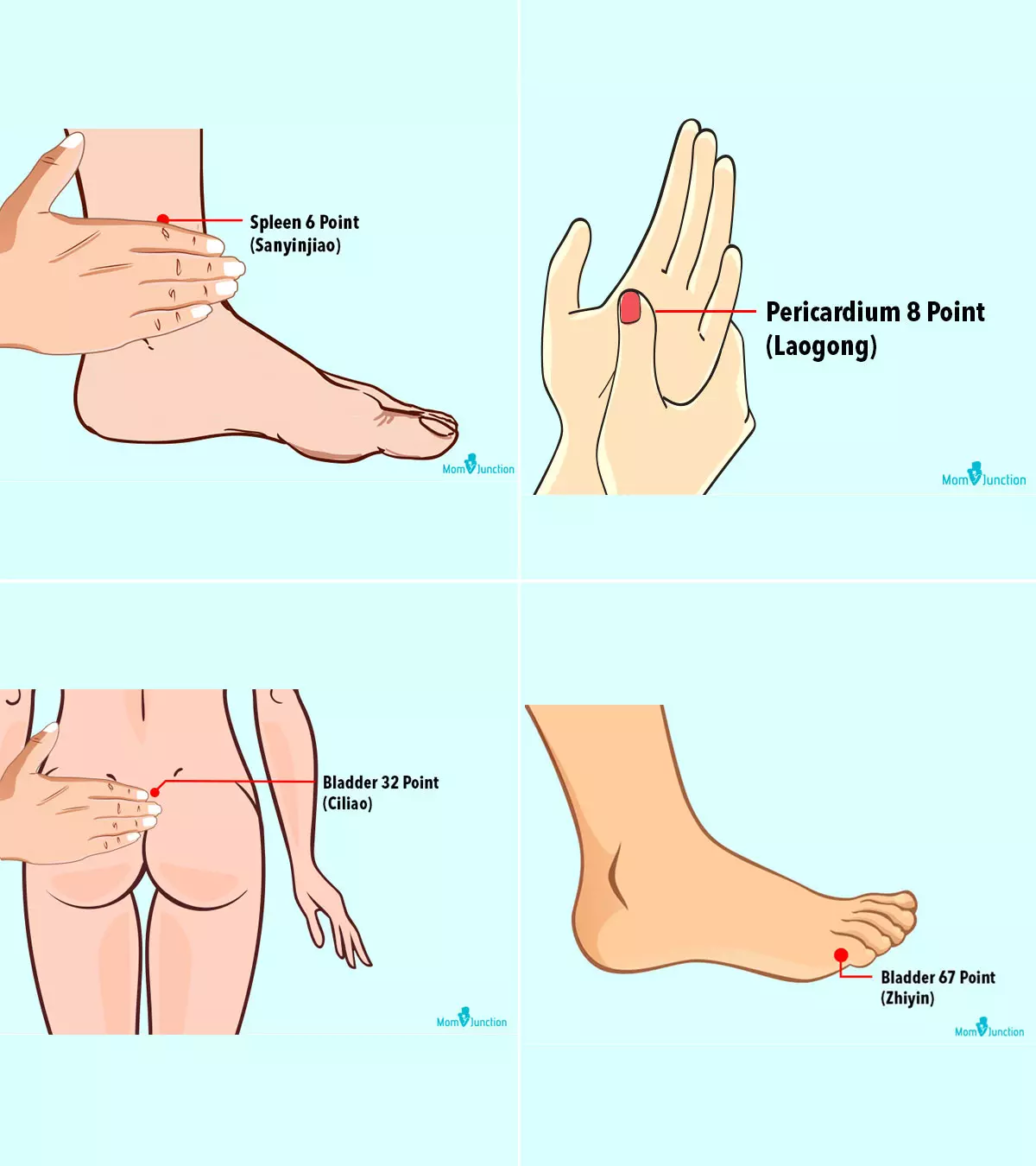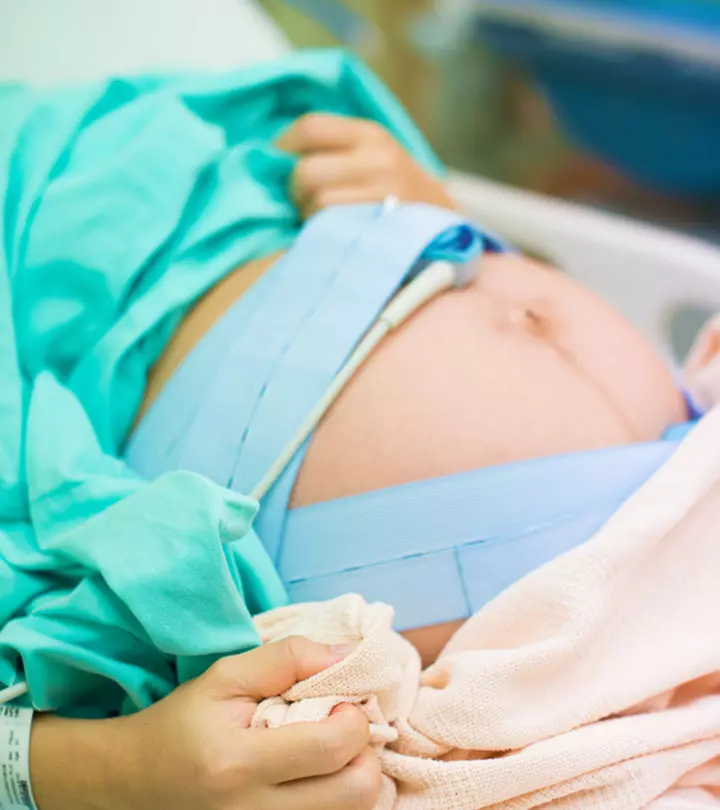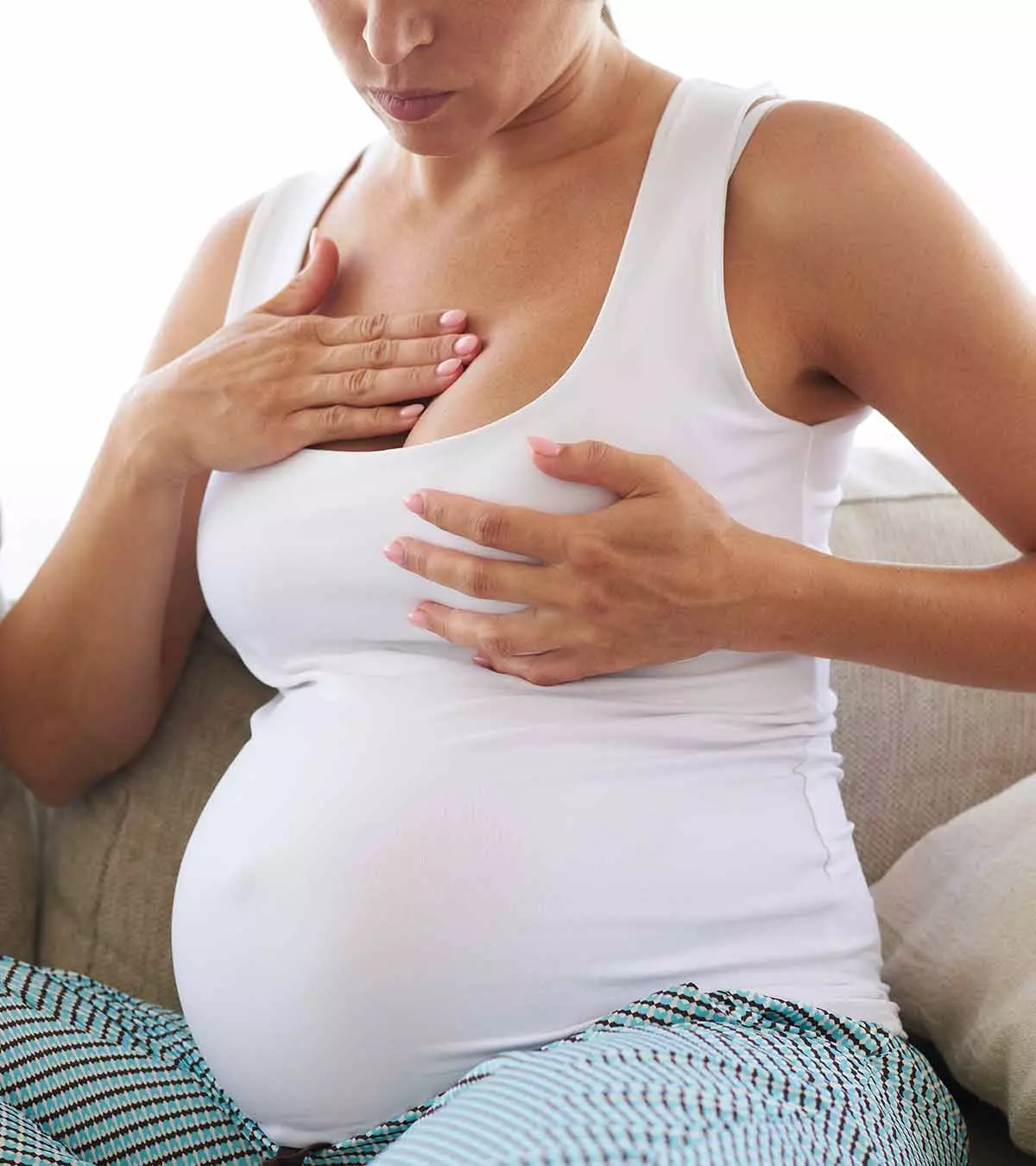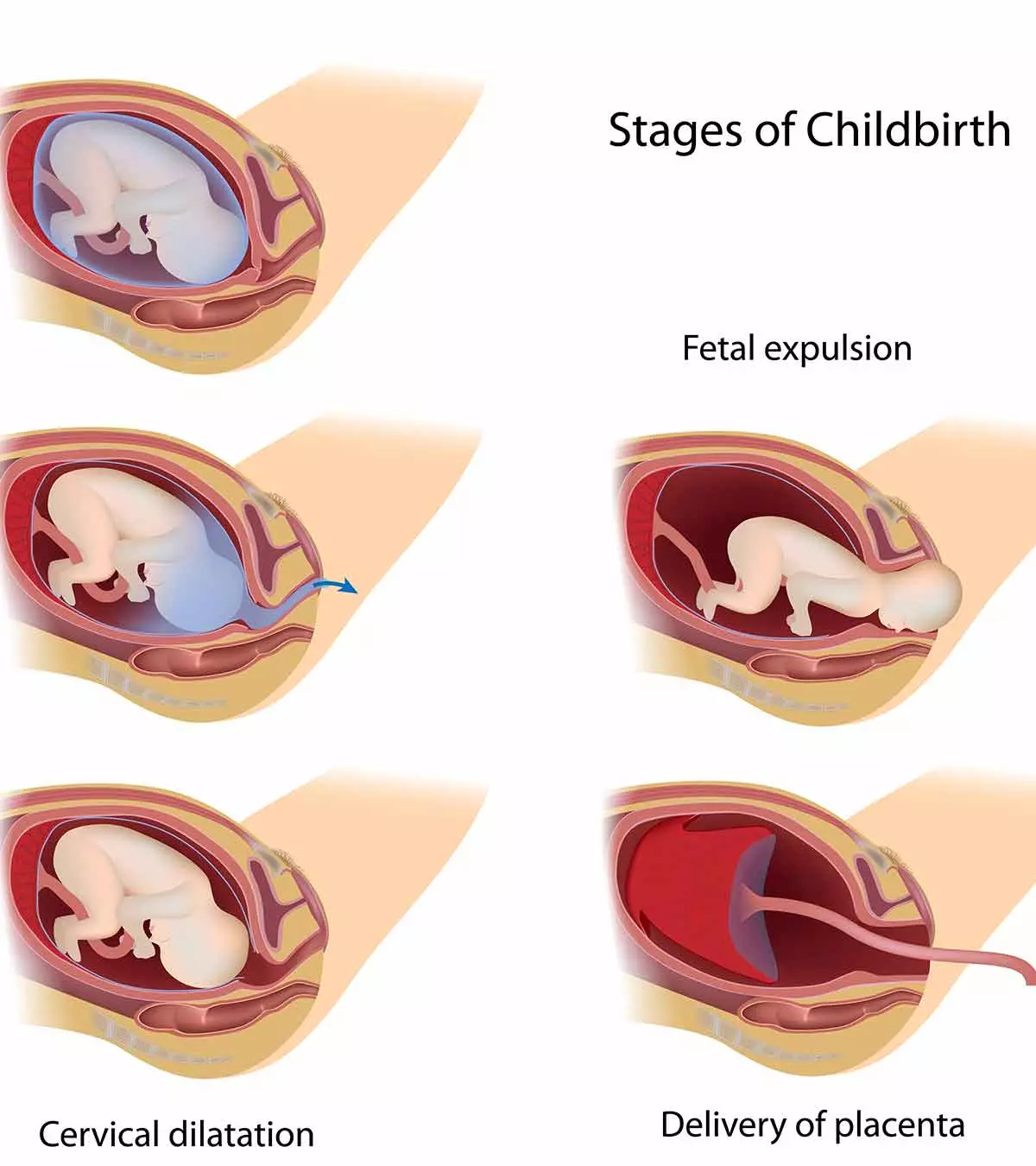
Image: ShutterStock
As is common knowledge, labor pain during vaginal birth is characterized by strong uterine contractions. Women who have undergone labor may have told you about their experiences of the pain involved and the associated difficulties. Knowing the details of the vital stages of labor may prove useful in making you better prepared for what is to come.
Labor pain is divided into three stages: early labor, active labor, and transition. Read this article to learn more about what happens during these stages and what you can do to make your labor easier and more comfortable.
Key Pointers
- Childbirth has three stages: the first stage of labor, the second stage of labor, and the third stage of labor.
- During the first stage of labor, contractions begin and the cervix begins to dilate.
- The second stage of labor lasts from 30 minutes to 2 hours and is characterized by a fully dilated cervix and contractions that are stronger and more prolonged.
- In the pushing phase, the pregnant woman will begin to push along with the contractions, and the baby is born.
- In the third stage of labor, which lasts an average of six minutes, the placenta is delivered.
Stages Of Labor
Labor progresses in three stages. Let’s see what they are (1):
- The first stage: This is the longest part of labor and the latent phase may last up to 20 hours. It begins with the onset of the true contractions and lasts until the cervix is dilated to 10cm.
- The second stage: It lasts from cervical dilation until the delivery of the baby.
- The third stage: The process of childbirth ends with the delivery of the placenta.
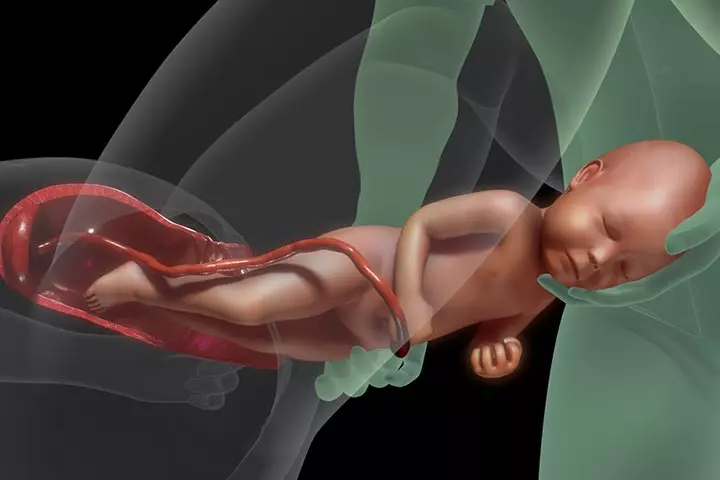
 Quick tip
Quick tipStage 1 Of Labor
This stage marks the onset of labor contractions that cause the cervix to soften and dilate.
Complete effacement is required for a smooth vaginal delivery. It involves three phases, namely early labor, active labor, and transition phase.
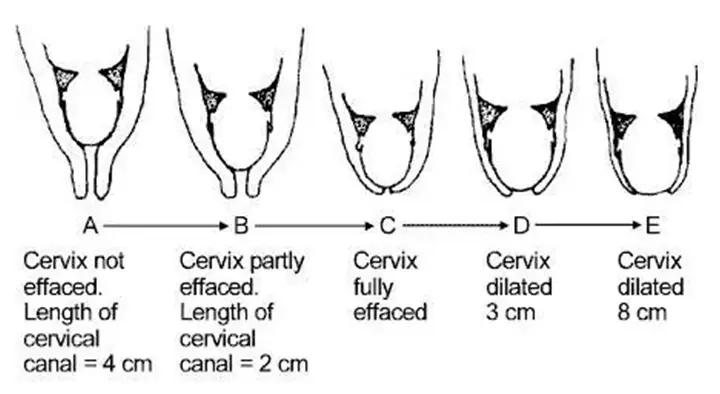
For your convenience, we’ve provided an explanation of the three phases in the first stage of labor:
| Phases in stage 1 of labor | What’s happening | What you can do |
|---|---|---|
Early labor
|
|
|
| Active labor |
|
|
| Transition |
|
|
Promptly at 3 am, right after the match, I felt strong contractions (similar to menstrual cramps) in my lower abdominal area. I slept it off as contractions are pretty common in the 9th month of your pregnancy. But in the morning, the contractions started to become more frequent and closer together. Instincts told me we should prepare to leave for the hospital, and I called my mother, who confirmed my suspicions. Then, at 12 noon, my ‘water bag’ (i.e., the amniotic sac containing the amniotic fluid) broke. I knew that because fluid kept dripping out of my you-know-what and onto my legs. It was time! I took a bath and got into some comfortable attire before heading to NUH (the hospital) (i).”
When to call the doctor?
Call your doctor or obstetrician right away if:
- The water breaks.
- Abdominal pain gets severe and constant.
- The baby’s movement slows down or stops.
- You have bright red vaginal bleeding, which is not normal.
Stage 2 Of Labor
The second stage involves pushing the baby into the birthing canal and eventually delivering. This stage progresses as follows:
- The cervix is fully dilated (10cm) by this time.
- This stage lasts for 30 minutes to two hours in the first-time mothers (4). Epidural can also prolong the length of the second stage of labor.
- Contractions get longer and stronger.
The pushing phase:
During this phase, the natural urge to push gets stronger. Along with that, you may also experience (5):
- Increased pressure in the perineum, rectum, and lower back.
- A strong bowel pressure.
- A burning or stretching feeling in the vagina due to crowning (the baby’s head moving down). At this stage, the woman is asked to stop pushing so that the perineum stretches gradually.
- Usually, there is a wait for the next contraction, then the baby is born.
- The baby comes out, usually with the head first.
What you can do:
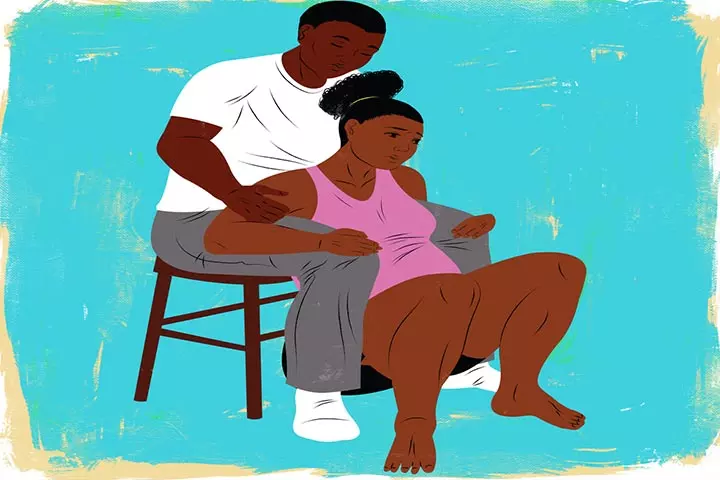
- Try different positions — squatting, lying on your side with your leg up or resting on your hands and knees.
- Take deep breaths before and after each contraction.
- Curl into push as much as possible, this allows all of your muscles to work.
- Concentrate on the contractions and take a break in between.
- Try different positions while sitting, standing, or walking.
- If you get hot flashes, use a cold face washer.
- Keep yourself hydrated by taking fluids.
Stage 3 Of Labor
After the baby is born, the placenta is delivered in the third stage.
- The average time of the third stage of labor is six minutes (6).
- Labor stimulation, analgesia during labor, and cord drainage could prolong the phase.
- The contractions begin 5-10 minutes after childbirth and are mild and less painful.
- The vagina feels fuller as the placenta passes through.
- Chills and shivering are common while you are delivering the placenta.
 Things to know
Things to knowWhat you can do:
- Stay relaxed.

- Ask the doctor, if you wish to see the placenta.
- Begin breastfeeding your baby after the delivery.
What Happens After Labor?
After the delivery of the baby, i.e., postpartum, the placenta is expelled from the uterus. If the placenta fails to come out after 30 minutes of childbirth, the condition is known as retained placenta and may be harmful to the mother. The medical personnel may assist you by injecting drugs such as Syntocinon (7).
In case of any tears in the vaginal area, the doctor will place the stitches by giving local anesthesia. This anesthesia will be given only if you did not get one during labor (1).
 Quick fact
Quick factFrequently Asked Questions
1. At what stage of labor is epidural given?
Epidural is given when you are 4-5cm dilated and have regular contractions. However, an epidural can slow down the contractions. In this case, Picotin will be given to speed up the labor.
2. What does it feel like when I start to dilate?
As the cervix dilates, it becomes softer. You can insert a finger into the vaginal opening that feels like soft lips. While doing this, you may probably feel the head of your baby.
3. Which stage of labor is the longest and how long does it last for?
The duration of labor varies from woman to woman. The first stage of labor is usually the longest, and for first-time moms, it may last from 6 to 20 hours. However, in those who have had babies earlier, this stage could be quite shorter lasting for 2-10 hours. Moreover, if the cervix is not dilated properly or the fetus is not in the optimal position, then it is certain that the labor will get prolonged.
4. Do I have to get a cut or episiotomy?
You may experience a perineal tear, which could be sutured by your midwife or doctor. You might also have an episiotomy, if necessary, while pushing. An episiotomy is a procedure in which a small incision is made in the second stage of labor to quickly enlarge the opening for the baby to pass through. It should only be done in an urgent situation to make the opening wider for the baby. The incision begins at the posterior fourchette and travels laterally, right or left, at a 45 to 60-degree angle to avoid injury to the anal sphincter muscles. This will help in the delivery of your baby and prevent large irregular tears of vaginal walls (8).
5. What are the potential complications of labor and delivery?
Complications during labor and delivery may include labor not progressing, perineal tears, wrapping of the umbilical cord in baby’s neck or limbs, abnormal fetal heart rate, perinatal asphyxia (fetus not getting enough oxygen), shoulder dystocia (baby’s shoulder getting stuck during delivery, and excessive bleeding (9).
6. What is the significance of the baby’s position in labor?
The cephalic presentation, or head-down position of the baby, is considered most suitable for a normal delivery because it is easier and safer for the baby to pass through the birth canal (10).
7. What is the purpose of oxytocin during labor?
Oxytocin is the key hormone that stimulates uterine contractions during labor. Plasma oxytocin concentrations gradually increase during the first and second stages of labor with a surge at birth (11). The hormone may also be injected to increase uterine activity if the labor fails to progress (12).
8. What is the role of a doula during labor?
A doula provides emotional and physical support during labor, helping with pain relief, breathing, and positioning. They also offer encouragement, assist in sharing your preferences with the medical team, and provide helpful information to make your birth experience smoother and more informed.
The three stages of labor are vital. Call your doctor promptly if you experience abdominal pain or vaginal bleeding during the first stage. The second stage is the pushing phase, where the baby starts coming out through the birthing canal. In the third stage, the childbirth ends, and the placenta is delivered. After labor, the doctor injects medications to stop the blood loss and stitches the vaginal area if there are any tears. Labor is associated with certain discomforts; however, staying calm, distracting yourself, and drinking fluids may ease the process.
Infographic: What Happens During Different Stages Of Labor?
Now that your pregnancy term is over, you may go into labor at any time to welcome your little angel to the world. It is a three-stage process and may make you feel worried. However, knowing about things you would experience during these stages may help you prepare yourself mentally. The following infographic explains a few important points about each stage of labor.

Illustration: Momjunction Design Team
Illustration: Vital Stages Of Labor: What Happens In Them And What To Do

Image: Dall·E/MomJunction Design Team
This informative video is all about the stages of labor and how to prepare for childbirth. Discover the physical and emotional changes that occur during labor and delivery.
Personal Experience: Source
MomJunction articles include first-hand experiences to provide you with better insights through real-life narratives. Here are the sources of personal accounts referenced in this article.
i. My Birth Story: the Day I Became a Mother;http://www.madpsychmum.com/2011/05/my-birth-story-day-i-became-mother.html
References
- Stages of Labor.
https://www.bidmc.org/centers-and-departments/obstetrics-and-gynecology/programs-and-services/pregnancy/labor-and-delivery/stages-of-labor - What are the stages of labor.
https://www.nichd.nih.gov/health/topics/labor-delivery/topicinfo/stages - First Stage of Labor.
https://americanpregnancy.org/healthy-pregnancy/labor-and-birth/first-stage-of-labor/ - Overview of Labor.
https://www.stanfordchildrens.org/en/topic/default?id=overview-of-labor-90-P02896 - Stages of labour.
https://www.thewomens.org.au/health-information/pregnancy-and-birth/labour-birth/stages-of-labour - Mahboubeh Taebi et al.; (2012); The duration of the third stage of labor and related factors.
https://www.ncbi.nlm.nih.gov/pmc/articles/PMC3696975/ - Retained placenta.
https://americanpregnancy.org/healthy-pregnancy/labor-and-birth/retained-placenta/ - Kyle Barjon and Heba Mahdy; (2021); Episiotomy.
https://www.ncbi.nlm.nih.gov/books/NBK546675/ - What are some common complications during labor and delivery?
https://www.nichd.nih.gov/health/topics/labor-delivery/topicinfo/complications - Your baby in the birth canal.
https://medlineplus.gov/ency/article/002060.htm# - Kerstin Uvnäs-Moberg et al.; (2019); Maternal plasma levels of oxytocin during physiological childbirth – a systematic review with implications for uterine contractions and central actions of oxytocin.
https://bmcpregnancychildbirth.biomedcentral.com/articles/10.1186/s12884-019-2365-9 - Pedro Hidalgo-Lopezosa et al.; (2016); Labor stimulation with oxytocin: effects on obstetrical and neonatal outcomes.
https://www.ncbi.nlm.nih.gov/pmc/articles/PMC4982443/#
Community Experiences
Join the conversation and become a part of our nurturing community! Share your stories, experiences, and insights to connect with fellow parents.
Read full bio of Jules Brooks
Read full bio of Sakshi Mishra
Read full bio of Rebecca Malachi
Read full bio of Dr. Joyani Das








